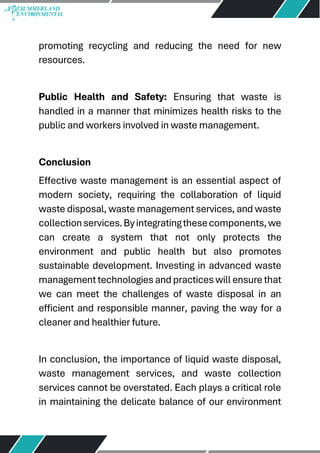Unknown Facts About Reclaim Waste
Unknown Facts About Reclaim Waste
Blog Article
Examine This Report about Reclaim Waste
Table of ContentsReclaim Waste Fundamentals Explained5 Simple Techniques For Reclaim WasteFacts About Reclaim Waste Revealed8 Easy Facts About Reclaim Waste ExplainedThe smart Trick of Reclaim Waste That Nobody is Talking About
Discover the kinds, events, and kinds of liquid waste. Residential sewer waste refers to the waste and products from a residential septic system. This kind of waste is produced by human beings in homes, schools, and various other structures. This only includes septic tanks that have a drainpipe area. The correct monitoring and disposal of residential sewage waste require fluid waste to be transferred to a sewer treatment plant where the appropriate methods and equipment are related to cleanse and dispose of waste.
Business waste typically includes prospective threats, such as flammable products or a blend of fluid and strong waste items, and requires a more innovative and comprehensive disposal procedure. The disposal of business waste normally involves the filtering of waste prior to transportation to make sure safe and appropriate disposal. Industrial waste is produced from results and runoff of industrial processes and production.
This sort of waste can not use the exact same sewer administration transport or processes as septic or industrial fluids. The hazardous waste administration procedure needs the evaluation and screening of liquid waste before it undergoes the disposal procedure (liquid waste removal). Overflow waste is the liquid waste that originates from overflow and excess stormwater in highly inhabited locations or cities
Overflow waste can trigger contamination and flooding if not managed effectively. Making certain correct waste monitoring can protect against disasters and decrease environmental harm.
Reclaim Waste Things To Know Before You Get This
Contact PROS Solutions today to find out about our waste administration and disposal solutions and the appropriate means to take care of the fluid waste you create.
(https://www.pubpub.org/user/leon-aube)This so-called 'wastewater' is not just an important source however, after therapy, will certainly be launched to our land, waterways or the sea. Used water from bathrooms, showers, bathrooms, kitchen area sinks, washings and industrial procedures is understood as wastewater.

water utilized to cool machinery or tidy plant and devices). Stormwater, a kind of wastewater, is overflow that moves from agricultural and city areas such as roofing systems, parks, yards, roads, courses and rain gutters into stormwater drains pipes, after rainfall. Stormwater flows without treatment straight to local creeks or rivers, eventually reaching the sea.
The smart Trick of Reclaim Waste That Nobody is Talking About
In Queensland, a lot of wastewater is dealt with at sewer therapy plants. Wastewater is transported from domestic or industrial sites through a system of sewers and pump terminals, recognized as sewage reticulation, to a sewer treatment plant.
The Division of Natural Resources advises city governments concerning handling, operating and preserving sewerage systems and treatment plants. In unsewered areas, neighborhood federal governments might need homeowners to set up individual or household sewage therapy systems to deal with domestic wastewater from toilets, kitchens, restrooms and laundries. The Division of Natural Resources authorizes making use of home systems when they are proven to be reliable.
Most stormwater obtains no therapy. In some new neighborhoods, treatment of some stormwater to remove clutter, sand and crushed rock has started making use of gross toxin catches. Wastewater therapy happens in four phases: Eliminates solid matter. Bigger solids, such as plastics and other things incorrectly discharged to sewage systems, are gotten rid of when wastewater is passed with screens.
Makes use of tiny living microorganisms knows as micro-organisms to break down and get rid of remaining liquified wastes and great particles. Micro-organisms and wastes are integrated in the sludge.
All about Reclaim Waste
Nutrient elimination is not readily available at all sewage therapy plants because it needs costly specialised devices. It is coming to be much more typical in Queensland. Clear fluid effluent generated after treatment might still consist of disease-causing micro-organisms. If this effluent is launched right into rivers such as rivers or the sea, the micro-organisms will at some point pass away out.

Most wastewater moves right into the sewerage system. Under the Act, local federal governments provide approvals and licences for eco appropriate activities (Periods) including wastewater releases that might have Full Report a neighborhood effect.
The Single Strategy To Use For Reclaim Waste
Or else, samples are considered lab analysis. Frequently many examinations are required to establish the degrees of each of the different contaminants such as oils, hefty metals and pesticides in water. Surveillance offers accurate details regarding water top quality and can confirm that licence conditions are being fulfilled. The details obtained with tracking gives the basis for making water quality decisions.
Report this page